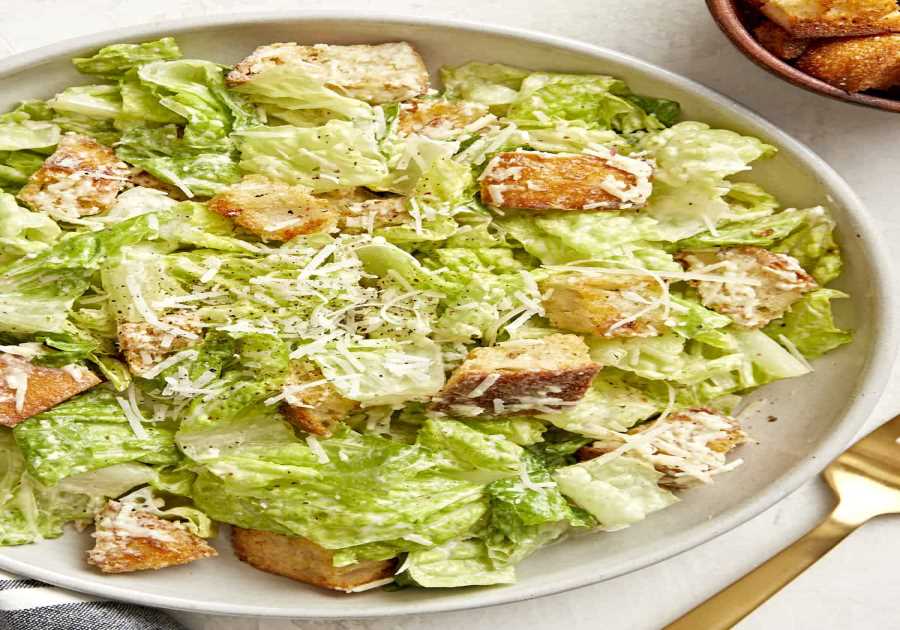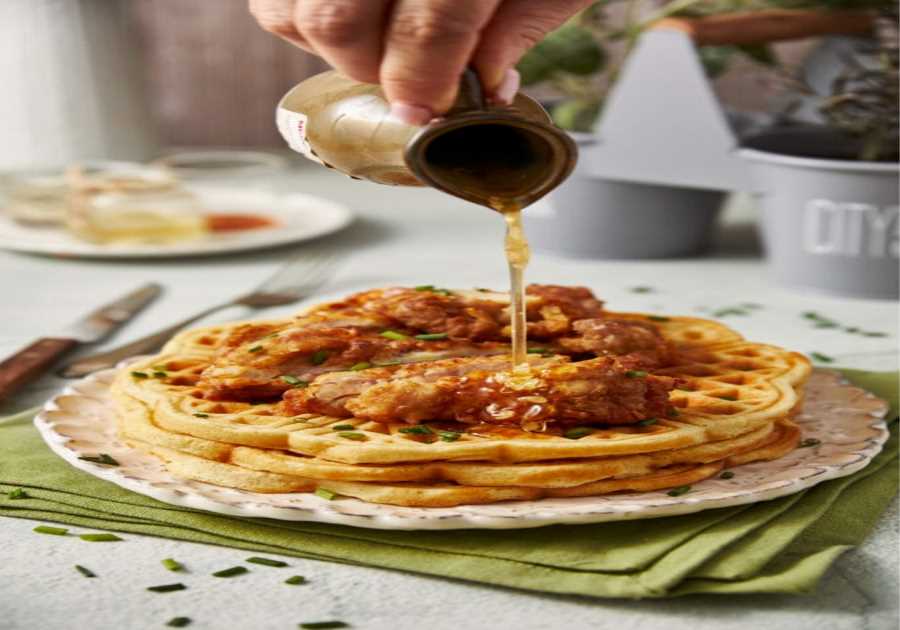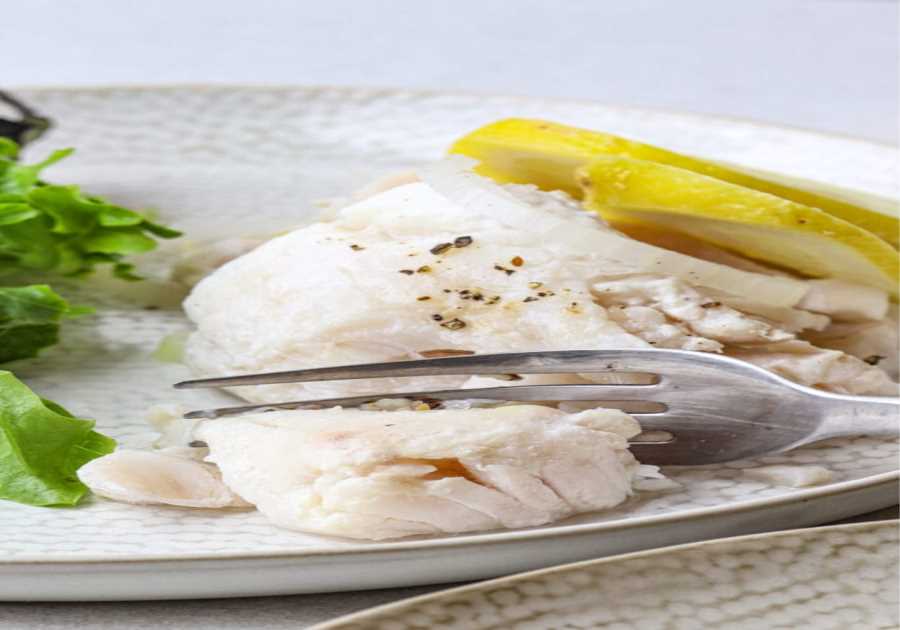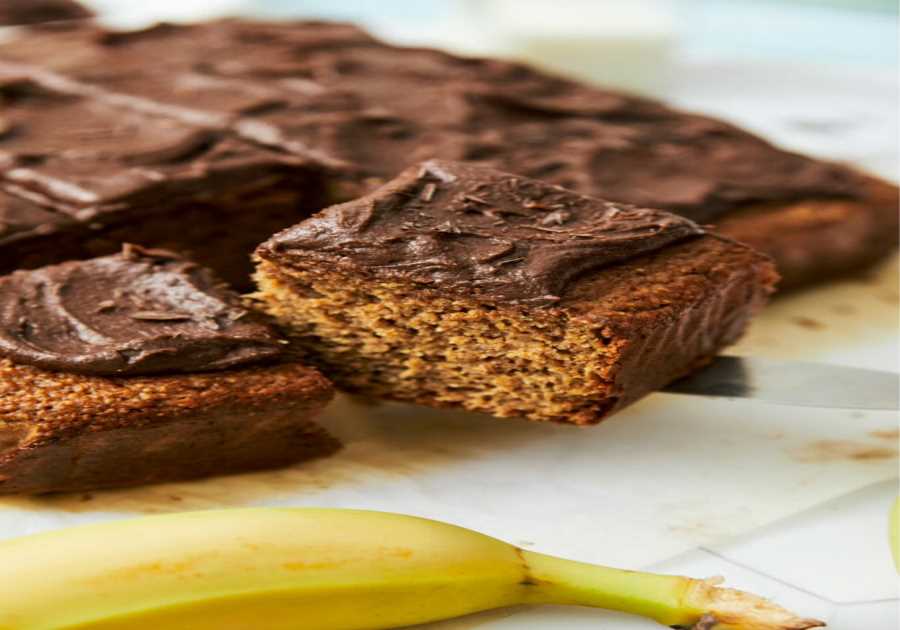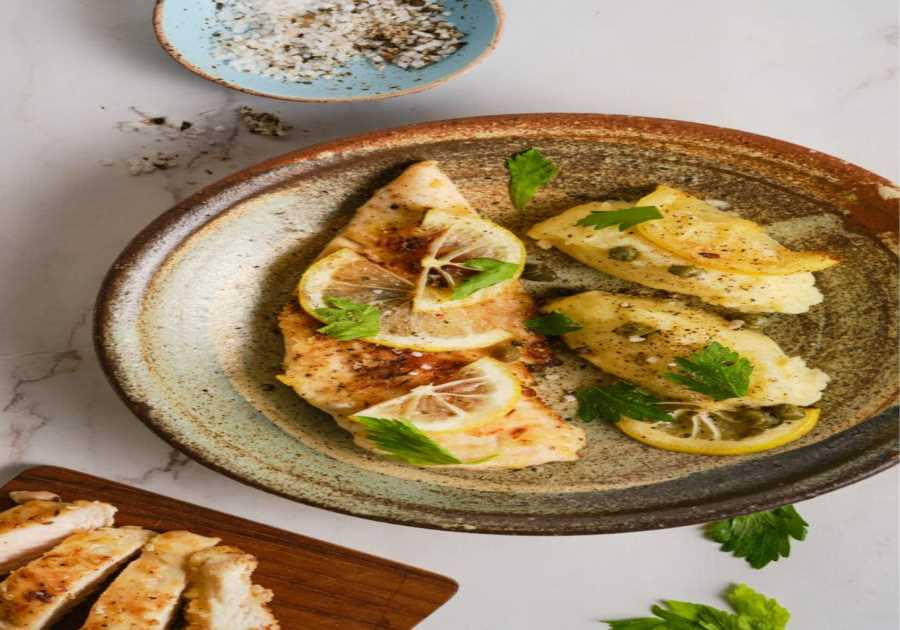For now, love yourself and enjoy this one ...
Now love yourself and enjoy this one ...
Add a savory spin to your breakfast with this recipe for Spinach Scrambled Eggs—fluffy yellow clouds of protein combined with nutrient-rich greens.
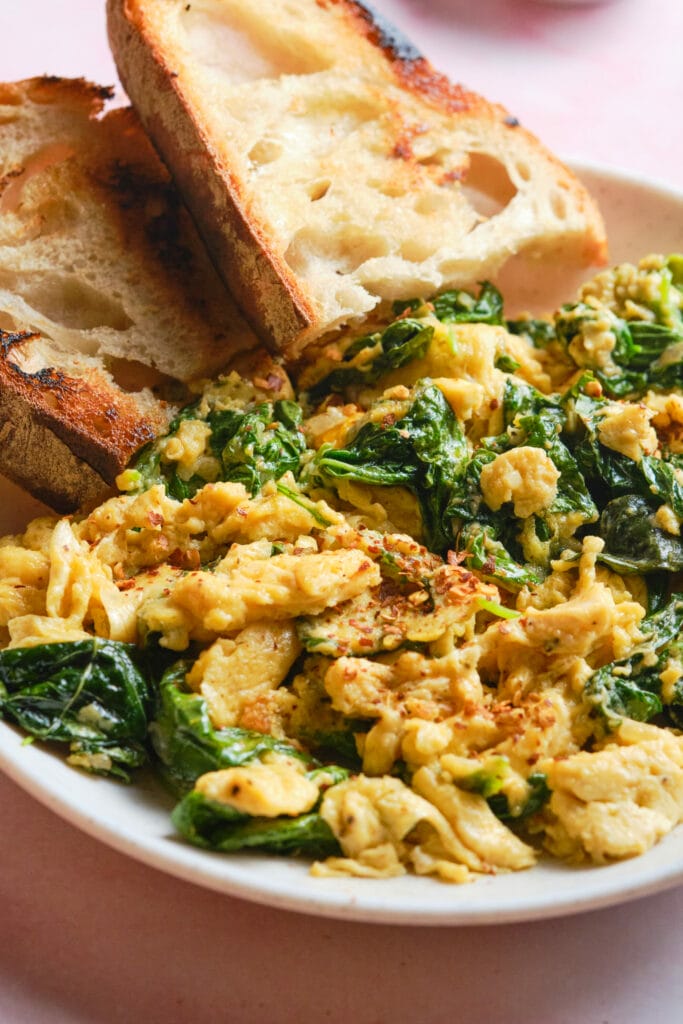
Table of Contents
I turn to scrambled eggs any day of the week. They are quick, easy, and healthy. They are also relatively cheap when compared to other grocery staples. Scrambling them doesn’t require an entire team of other ingredients in order to enjoy them. Just a bit of fat (I’m partial to butter but olive oil is a healthy alternative) and the eggs and I’m good to go.
Sometimes, though, I want to take them to the next level. Not several levels beyond, mind you, but slightly more substantial than your basic egg. That’s what I love about this recipe. With the addition of spinach, I am getting even more nutrients, more flavor, and more food, which means I feel full longer (though I know that’s not always the case with more food).
I’ve gone ahead and added shallots, red pepper flakes, and Parmesan cheese to make this more “gourmet”; feel free to add or remove any ingredients according to your palate. Then get ready to enjoy a dish that can be whipped up in minutes any time of the day!
Are Spinach Scrambled Eggs Healthy?
Indubitably! (That means, ‘yes’.) Eggs are packed with protein, energy, and vitamins. Plus, they’re good for your blood cholesterol. Spinach, meanwhile, is good for your heart, eyes, and may reduce the risk of cancer. The dish is suitable for low-carb & keto diets, as well as vegetarian, gluten-free, and Mediterranean diets. To make it suitable for paleo diets, drop the cheese and use ghee butter. Do the same if you’re on a whole30 diet.
Do I Need To Add Milk Or Water To My Scrambled Eggs?
It’s all a matter of preference. Some find milk makes creamier and more tender scrambled eggs. Those who add water say their eggs turn out fluffier and lighter than eggs with milk. Personally, I can’t say I’ve noticed much of a difference. If you want to experiment, start with 1–2 tablespoons of either milk or water for every few eggs you cook and then go from there. If you find milk does make a positive difference, try cream out and see whether it makes a good thing even better.
INGREDIENTS
- 4 large eggs
- 1 tbsp Parmesan cheese, grated
- 1 tbsp butter, unsalted
- 1 small shallot, minced
- 1 clove garlic, minced
- 2 cups fresh baby spinach leaves
- pinch red pepper flakes
- pinch of sea salt and black pepper
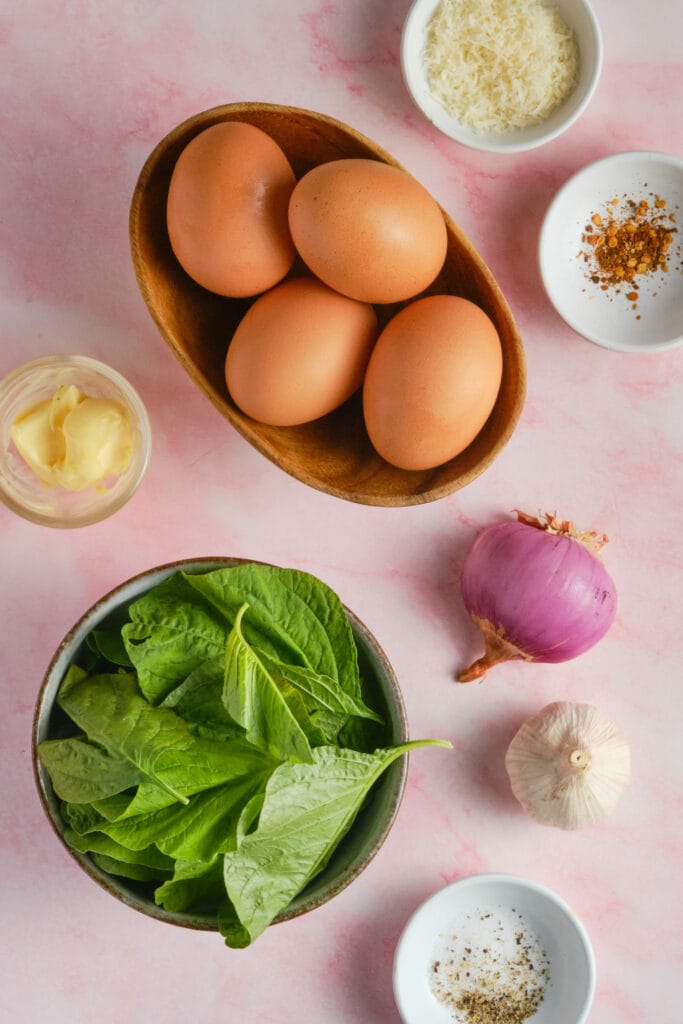
INSTRUCTIONS
Whisk
Combine eggs and Parmesan in a bowl. Season with salt and pepper. Set aside.
Cook
Melt butter in a skillet over medium heat. Cook shallots till translucent, then add garlic for 30 seconds.
Add
Add spinach to skillet, cook till wilted.
Scramble
Pour egg mix into skillet. Let it sit till edges set, then mix until desired doneness.
Garnish
Plate eggs and garnish with red pepper flakes.
DEVOUR!
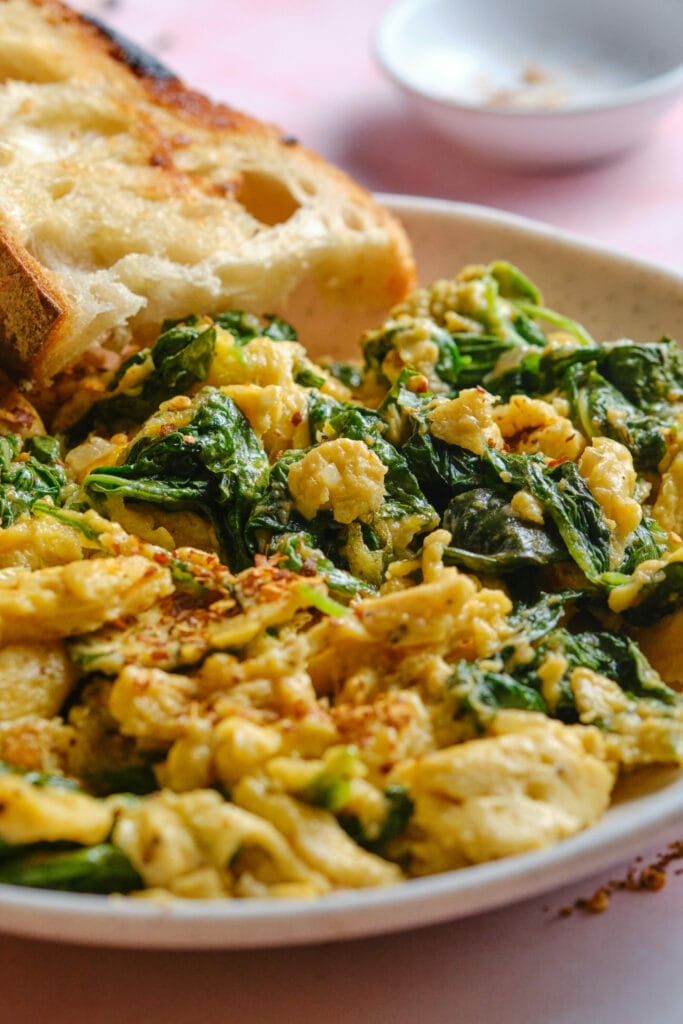
FAQs & Tips
Let the eggs cool completely then store in an airtight container. They should keep in the fridge for up to 3 days. And while it’s possible to freeze spinach scrambled eggs, I don’t recommend it. Both the eggs and the spinach contain a lot of water; freezing them will alter the texture… for the worse. You’re better off refrigerating the scrambled eggs and throwing them out if they seem past their prime.
I rarely make scrambled eggs more than an hour ahead of time, and this is usually only when I am expecting guests and need to make lots of it. In such cases, I’ll turn on my oven on LOW and keep the eggs warm inside until it’s time to serve them out. To make them further in advance, look at the question above.
There are 205 calories in each serving of this dish, with each serving comprising two eggs. Eggs are nutrient dense, which is a good thing. They will keep you satiated longer and give you the energy you need first thing in the morning.
Sure, the main difference is the amount you fold the eggs. Scrambled eggs call for numerous folds (i.e., scrambling) while an omelet requires just the one. If you do go the omelet route, your biggest decision is whether to mix the eggs and spinach together or cook them separately, only to put the spinach in the fold of the cooked egg, like a soft taco! I prefer the latter, as mixing the two could make it difficult for your egg to remain cohesive.
Sure. The important thing is that you adequately squeeze out all the moisture or else your meal will turn into a sloppy mess. You may even end up poaching your eggs if you’re not careful!
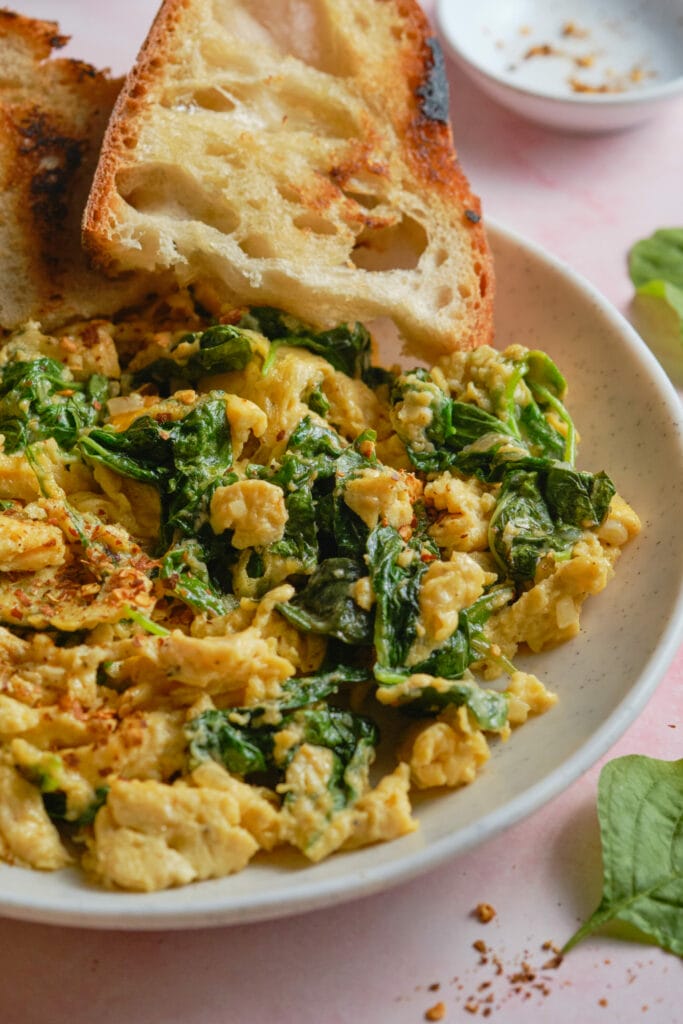
Serving Suggestions
As I said earlier, I like Spinach Scrambled Eggs for its simplicity and how full I feel despite that simplicity. But if you are wanting to make it part of a larger meal, I do have ideas. First on the list is bacon. Here’s a recipe that goes over how to do bacon in the oven. It’s another low-maintenance recipe that won’t stress you out on a Sunday morning. You can then add a sweet stack of chocolate-chip pancakes but balance them out with a healthy dose of my Easy Vegan Granola. Put out some yogurt and cottage cheese (separately, not in the same bowl) and your guests should have a lovely little spread to feast from.
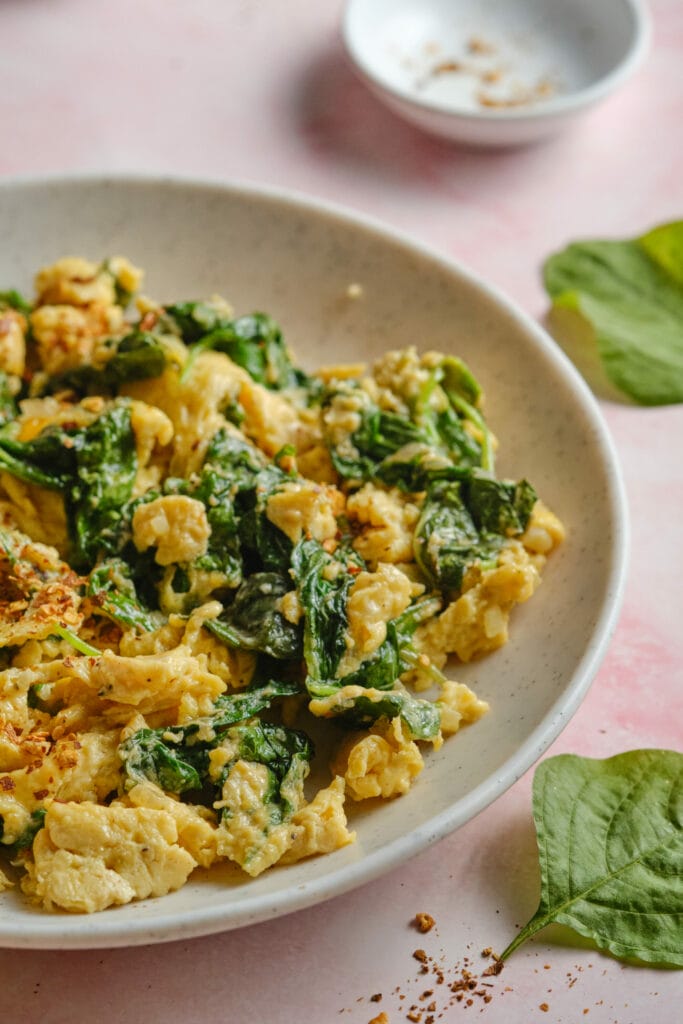

Spinach Scrambled Eggs
Ingredients
- 4 large eggs
- 1 tbsp Parmesan cheese grated
- 1 tbsp butter unsalted
- 1 small shallot minced
- 1 clove garlic minced
- 2 cups fresh baby spinach leaves
- pinch red pepper flakes
- pinch of sea salt and black pepper
Instructions
- In a medium-sized bowl, whisk the eggs together with the grated Parmesan cheese. Season and set aside.
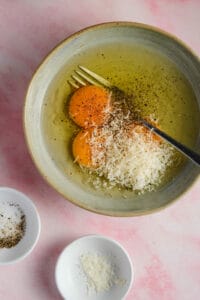
- Melt the butter In a nonstick skillet over MEDIUM heat. Add the shallots. Cook for 2-3 minutes until translucent. Add the minced garlic and cook for 30 seconds.
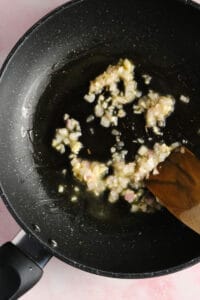
- Add the spinach to the skillet. Cook for 2 minutes, until it wilts.
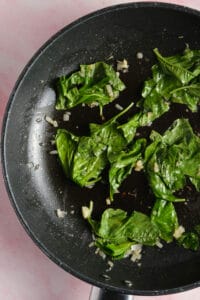
- Pour the prepared mixture into the skillet. Let sit until the edges begin to set. Using a spatula, gently fold the eggs until they reach the preferred level of doneness.
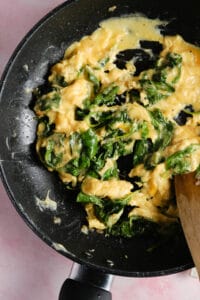
- Transfer to a plate. Garnish with a sprinkle of red pepper flakes.
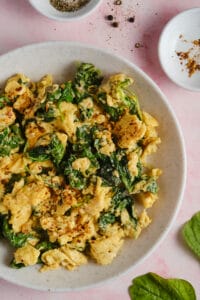
Nutrition
The post Spinach Scrambled Eggs appeared first on Food Faith Fitness.
References:
By: FoodfaithfitnessTitle: Spinach Scrambled Eggs
Sourced From: www.foodfaithfitness.com/spinach-scrambled-eggs/
Published Date: Tue, 05 Mar 2024 21:07:50 +0000
Frequently Asked Questions
Should You Use Herbs and Spices for Brain Health?
Herbs and spices have been used for centuries to improve brain health. Research shows that these natural remedies may help prevent dementia and Alzheimer's. Some herbs may even boost memory.
However, no scientific evidence proves that eating an herb-rich diet can keep your mind sharp. When it comes to improving cognitive function, there are more effective ways to do it.
One study found that older adults who took 1000 mg of vitamin B6 daily had fewer mental lapses than those taking placebo pills. Another study showed that drinking coffee could increase blood flow to the brain. Other studies suggest that exercise, socialization, and sleep improve brain health.
The bottom line is that herbs and spices probably won't make much difference to your overall health. But they might give you extra energy and focus, which can come in handy during the day.
Which herbs are healing herbs?
If you look for healing herbs, you won’t find them in the supermarket. There isn’t any place to buy them. There is no store selling them.
You haven’t been able to find healing herbs because they aren’t sold anywhere. They are grown right here in our backyard.
Healing herbs are plants that grow naturally in North America. Like many common household items, these herbs grow throughout the United States and Canada.
These herbs treat minor ailments such as colds, flu, sore throats, coughs, and headaches. Many of these herbs have been used for centuries to help heal wounds and promote overall health.
Of course, when we say “heal,” we mean more than simply treating an illness. We also refer to the ability of these herbs to restore balance and harmony within ourselves and the world around us.
For example, the chamomile herb helps relieve stress. This means that if you feel stressed out, you may benefit from taking chamomile tea. Chamomile tea has been shown to reduce anxiety and nervous tension.
In addition, chamomile tea has been proven effective in relieving insomnia.
Chamomile tea has many other benefits, including its ability to ease stomach aches and gas pains and even improve digestion.
Another popular healing herb is Echinacea. Echinacea is known for helping to fight infections and boosting the immune system.
Echinacea is commonly taken internally and externally to fight infection, prevent viral diseases, and boost immunity. It is safe to use during pregnancy and lactation.
Echinacea also helps reduce muscle pain and inflammation. You can take echinacea orally or topically (as an ointment).
This herb is available in both liquid and capsule form. Liquid echinacea is often mixed with honey and lemon juice. The mixture is then strained and consumed.
Capsules are usually made of freeze-dried plant material. They contain standardized amounts of active ingredients. To use capsules, swallow one or two a day.
The third type of herbal remedy is called tincture. Tinctures are alcoholic extracts of herbs. They are typically used to treat internal problems. Tinctures are generally diluted before being ingested.
Tinctures can be taken orally or applied topically. For oral consumption, dilute tinctures with water. Some people prefer to mix tinctures with food.
Tinctures are easy to prepare. Put about one tablespoon of dried herb into a bottle containing enough alcohol to cover the herb completely. Allow the mixture to sit for several weeks. Then strain and consume.
You may want to try some of these natural remedies to see which ones work best.
Why do some love coriander and others don't?
Some people hate coriander, while others love it. But why?
Coriander is an herb that grows in warm climates throughout the world. It is native to both North America and Europe.
The leaves of the plant are used in cooking and can also be found in condiments such as salad dressings and dips. When added to food, coriander provides a spicy flavor.
Many people love its taste because it adds a fresh flavor to dishes without overpowering them. Others dislike the smell and taste of coriander because they find it too strong.
But there is more to coriander than meets the eye. There are two types of coriander – sweet and hot. Sweet coriander is milder and sweeter tasting compared to hot coriander.
Sweet coriander is usually grown for its seeds, often called cilantro. This type of coriander is easy to grow and is very low maintenance.
Hot coriander is most commonly used in Indian cuisine. Hot coriander gives a rich flavor to curries and sauces, making it popular among Indians.
Some people say that hot coriander tastes better than sweet coriander. However, the opposite is true for those who prefer sweet coriander.
There are many reasons why people enjoy different varieties of coriander. For example, one person may love the taste of coriander, while another enjoys the aroma.
Whether you like sweet or hot coriander, you might be surprised to learn that you can buy both types of coriander online.
What herb is best for healing?
Herbs are a fantastic way to help heal our bodies. Herbal medicine has been used since ancient times and continues to grow today. There are thousands of herbs known to cure various ailments.
Some herbs are excellent for treating colds and flu, while others can treat anxiety, depression, arthritis, cancer, diabetes, heart disease, and more.
There are also herbal remedies for skin care, hair loss, weight loss, sexual health, energy, sleep, digestion, and much more.
The list goes on and on. But one herb stands above them all regarding its ability to heal. That herb is called aloe vera.
Aloe Vera is considered to be the world's most powerful healer. For centuries it has helped people heal themselves naturally without any side effects.
It's incredible how well aloe vera works. It's even better than prescription drugs and surgery.
In addition to its natural healing properties, aloe vera is highly versatile and can be used in almost any area of life, including food, beauty products, and household cleaning supplies.
You may not realize this, but aloe vera contains hundreds of active compounds, which include vitamins A, C, E, B1, B2, B3, B6, folic acid, calcium, magnesium, iron, zinc, copper, sulfur, manganese, phosphorus, potassium, sodium, chloride, fluoride, iodine, selenium and more.
These nutrients are essential for human body functions such as cell growth, metabolism, immune system support, healthy bones and teeth, healthy blood pressure levels, healthy eyesight, healthy cardiovascular systems, healthy digestive systems, healthy lungs, healthy nervous system, healthy reproductive organs, healthy skin, and healthy libido.
Which plant has antibiotic and wound-healing properties?
People often ask about plants that have medicinal uses. Some of these include aloe vera, eucalyptus, chamomile, and lavender. If you're wondering why there aren't any plants used for cleaning and disinfecting purposes, it's because most plants have toxic qualities.
The reason why we use herbs for medicine is that they contain compounds that stimulate our immune system. This means that they help us fight infections and heal wounds.
Some plants also have anti-inflammatory properties. These include ginger, turmeric, and mint.
Herbs such as basil, fennel, marigold, and oregano are great for cleansing the body.
There are even some plants that help prevent cancer. Research shows that black raspberries may reduce the chances of developing breast cancer. The same goes for broccoli. It can help prevent colon cancer.
How do you make medicinal herbs?
There are many different methods to make herbs into medicinal products. The most common method is to dry the herbs in a warm, dark location before grinding them into a powder or extracting their essential oils. This can be accomplished by hanging herbs upside down in bunches, laying herbs on a drying screen, or using a food dehydrator.
Once dried and ground, herbs can be stored in airtight containers for future use. Other herbs may require special preparation, such as infusing herbs into oil or vinegar, making tinctures with alcohol, or distilling herbs to create essential oils.
Learning the correct techniques for preparing herbs can help ensure that they retain their medicinal properties and potency for optimal health benefits. Using fresh herbs is usually best, but herbs can also be grown in a pot or garden and harvested when they are mature. Herbs can be purchased at health food stores, online retailers, and specialty shops.
No matter where herbs come from, the preparation techniques remain the same; drying herbs in a warm location followed by grinding or extracting the essential oils. You can make your medicinal herbs with the right herbs and preparation techniques.
When making herbal preparations, it is essential to remember that herbs can vary in potency, so always dilute herbs before use or follow the directions on any product label. Additionally, herbs are best used fresh, as many of their beneficial components degrade over time.
Following safety guidelines and paying attention to the potency of herbs can help ensure that you get the most benefit from your herbs. With a bit of practice and preparation, anyone can make therapeutic herbs with medicinal properties. Remember that herbs should never replace any medical advice or treatments prescribed by a doctor. Always consult a licensed healthcare professional before using herbs medicinally.
Statistics
- Herbs are among the most popular and widely used medicinal remedies. According to a survey conducted by the National Institutes of Health, herbs were used by over 38% of adults in the United States.
- The herbs market is highly competitive, with over 1,000 herb suppliers and over 15,000 herbs products available in the United States alone.
External Links
[TAG37]
[TAG39]
- Antioxidant capacity of 26 spice extracts and characterization of their phenolic constituents - PubMed
- Cinnamon: A Multifaceted Medicinal Plant - PMC
[TAG42]
[TAG44]
- Ashwagandha | Memorial Sloan Kettering Cancer Center
- Grape Seed | Memorial Sloan Kettering Cancer Center
How To
How to use herbs safely?
Many people think that herbs should only be used under medical supervision because they believe that some herbs are poisonous. However, this is not true.
Many herbs have long histories of safe use. For example, garlic has been used for thousands of years to fight infections. It's also been shown to lower cholesterol levels and reduce high blood pressure.
However, if you're pregnant or nursing, avoid taking certain herbs. You should also avoid them if you suffer from allergies or sensitivities to herbs.
You can do several things to ensure you get the best results from your herbs and supplements. First, always read labels before consuming anything containing herbs or spices. Second, take the lowest dose recommended on the label. Third, don't use more than one supplement at any given time. Fourth, talk to your doctor about how to combine specific herbs and supplements. Finally, keep track of your consumption to know whether you need to adjust your dosage.
 |
[TAG47]Hello hello! Just wanted to pop in with a cute little life update. ♡ I’m delighted to share that our sweet son, Milo Alexander Martin, came to join our family |
 |
[TAG48]This vibrant lemony broccoli pesto pasta is quick and easy to make and full of fresh flavors. Your veggies, greens, and pasta…all in one gorgeous dish! ♡ We’re |
 |
[TAG49]This simple roasted carrot soup recipe is made with creamy tahini and topped with crispy za’atar chickpeas. Naturally gluten-free, vegetarian and vegan. If you |
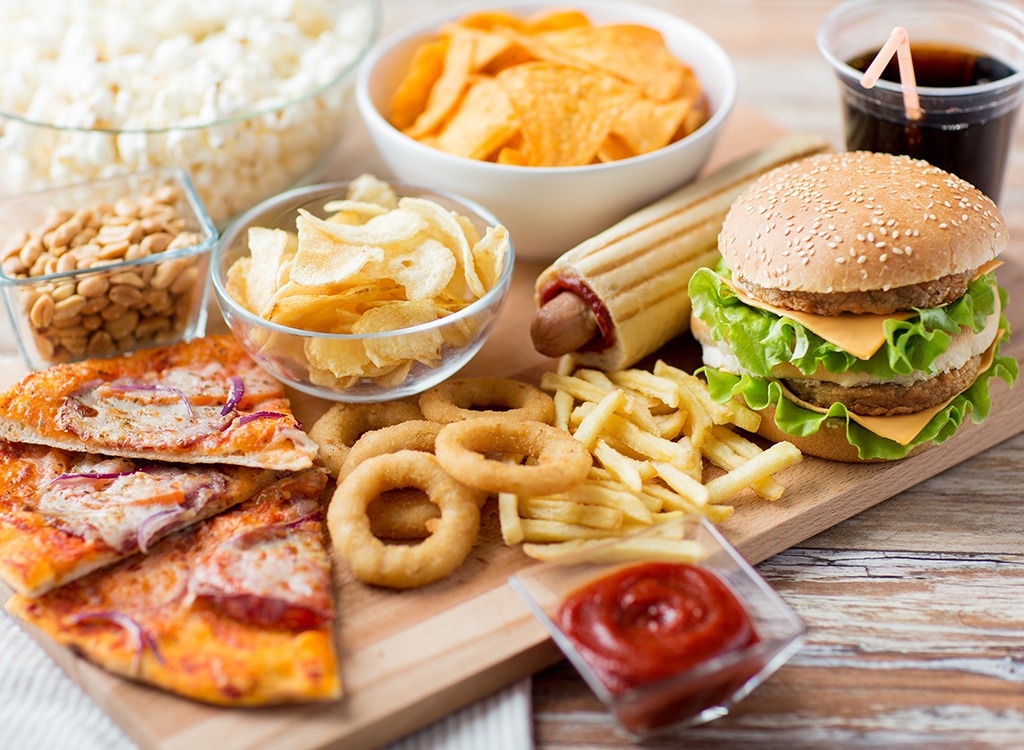 |
[TAG50]Easy to make full flavoured recipes. Life is too short for boring food! |
 |
[TAG51]My longtime favorite flourless cake recipe is decadently rich and delicious, naturally gluten-free, and easy to make in under 1 hour! Trust me, this flourless |
 |
[TAG52]This vegetarian cabbage roll soup is filled with protein-rich lentils and all of the delicious flavors you love from traditional cabbage rolls. Naturally |
 |
[TAG53]These zesty roasted sweet potato and chickpea bowls are layered with sautéed spinach and brown rice and tossed with my favorite 4-ingredient chipotle tahini |
 |
[TAG54]HEALTHY & KID-FRIENDLY MEALS easy dinner recipes made in minutes. The Latest Recipes st. Patrick's Day Recipes Hello! I'm Sara! Welcome to Dinner at the Zoo! |
 |
[TAG55]This classic matcha latte recipe is easy to make and customize to your liking and always so delicious. The older I get, the more I’m convinced that one of |
 |
[TAG56]This veggie-loaded broccoli cheese soup recipe is perfectly velvety and creamy without using heavy cream. Instant Pot, Crock-Pot and stovetop options all |
 |
[TAG57]This winter farro salad recipe is made with the most delicious blend of seasonal fruit, greens, nuts, crumbled cheese and tossed with a vibrant orange ginger |
 |
[TAG58]From comfort foods to indulgent dishes browse hundreds of recipes that your family will love and make over and over again. Cooking Classy has never been easier, |
 |
[TAG59]This lovely white wine sautéed mushrooms recipe is quick and easy to make, full of rich savory flavors, and can pair well as a side dish with many different |
 |
[TAG60]This traditional Swedish meatballs recipe is bursting with rich, savory flavors and topped with a creamy gravy. Always so comforting served over mashed |
 |
[TAG61]This classic Irish coffee recipe is easy to make with 4 ingredients in just a few minutes. Always so warm and cozy! Let’s warm up with a hot mug of Irish |
 |
[TAG62]A family food blog with hundreds of simple, tested and approved recipes. Find easy step-by-step photo cooking instructions and video recipes. |
 |
[TAG63]This snickerdoodle blondies recipe is irresistibly rich, buttery, tangy, and sprinkled with a crunchy cinnamon-sugar topping. Yes, they’re just as good as you |
 |
[TAG64]This creamy garlic mushroom orzo pasta recipe is easy to make and always so comforting and delicious. Say hello to one of my favorite back-pocket recipes |
 |
[TAG65]This 3-ingredient homemade dog treats recipe is quick and easy to make and cut into whatever shapes you love. This holiday cookie season, we can’t forget about |
 |
[TAG66]find out hundres of delicous food recipes |
 |
[TAG67]"Food Wars" hosts Harry Kersh and Joe Avella travel across NYC to find the best Bodega sandwich in the city. They'll be visiting four different locations in |
 |
[TAG68]🇮🇩 Street Food in Bali: 👕 T-shirts: 🌶 Ghost Chili: SURABAYA, INDONESIA: Welcome to Surabaya, the second biggest city in Indonesia, and an |
 |
[TAG69]This cake is based on the chocolate sheet cake recipe Ree made for years and years, originally given to her by her mother-in-law, Nan Drummond. Nan gave Ree |
 |
[TAG70]The food blog with mostly healthy recipes made with real, whole foods inspiring more people to get into the kitchen and cook something good. |
 |
[TAG71]A food blog with hundreds of quick and easy dinner recipes. Classics done right, incredible one pot recipes, Asian takeout at home and holiday feasting! |
Did you miss our previous article...
https://belovedsaffron.com/recipes/strawberry-smoothie
.png)

